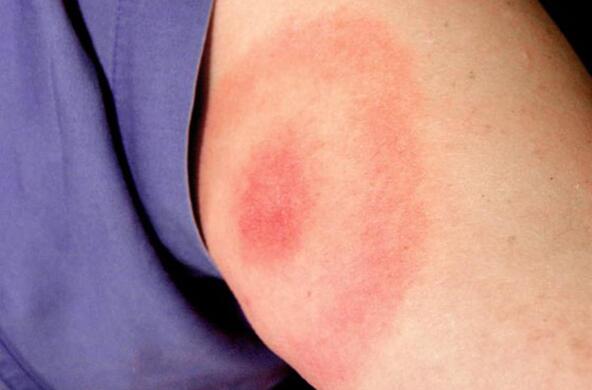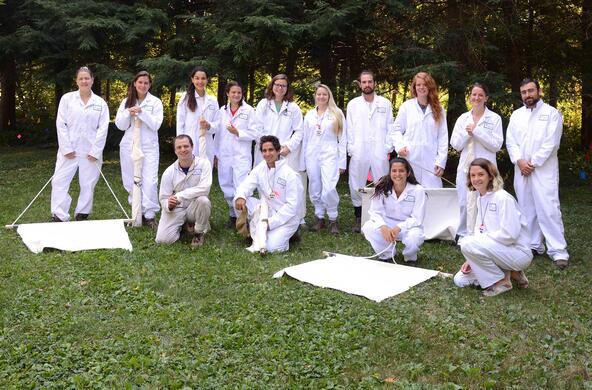Columbia County has "become ground zero" for Lyme disease, Rep. Chris Gibson, R-19, said recently.
It's a "major public health scourge," he said, especially in the Northeast — and it's spreading across the country.
During a Lyme forum held in early March, he said ever since he took office, Lyme disease has been at the top of his constituents' minds. During an April 18 phone interview, he said a symposium held in May 2012 in Saratoga on Lyme disease was "constituent driven."
But this "public health scourge" also weighs heavily on his mind. Gibson grew up in Kinderhook and after retiring from the Army in 2010, he, his wife and three children, moved back to his hometown. He said he's "very concerned on a personal level," as he has family and friends afflicted with Lyme disease.
As a resident in "ground zero," this may make him one of the best champions for better Lyme disease awareness, testing, treatment and research.
Gibson has teamed up with U.S. Sens. Kirsten Gillibrand, who called Columbia County home not that long ago, and Richard Blumenthal. The three legislators have partnered with the Tick-Borne Disease Alliance (TBDA) to build support in the fight against Lyme disease. The alliance is a national nonprofit organization dedicated to raising awareness and promoting advocacy to find a cure for Lyme and other tick-borne diseases.
The forum held in March brought together a panel of doctors, experts, advocates and even nationally syndicated cartoonist John McPherson, creator of the "Close to Home" comic, who has had Lyme disease since 1998.
During the forum, Gibson noted some of the investments are starting to take root and that last year, there was $8.75 million in appropriations for better testing.
Calling from his Washington, D.C. office, he said the five areas of Lyme he's focused on are awareness, testing, treatment, health care coverage and tick suppression.
With awareness, he said, there are steps individuals can take to lessen exposure, like wearing clothing in particular settings or when returning from certain areas, take a shower, check vulnerable areas on the body and tumble-dry clothes.
Testing is a major focus area. Gibson said there isn't a test to detect half of the Lyme cases. However, last summer, a hearing on the U.S. Capitol resulted in "encouraging developments," he said. And there's a researcher, he added, who's making progress on testing that goes beyond drawing blood for antibodies.
Richard S. Ostfeld, senior scientist at the Cary Institute of Ecosystem Studies in Millbrook, as well as a disease ecologist specializing in Lyme disease and West Nile Virus, said while "large advances have been made even with rather paltry funding," there needs to be "rapid improvements," such as better diagnostics for early-stage Lyme, "so that when patients see their doctors in the first few days or weeks after exposure, they're not incorrectly considered uninfected (based on a negative blood test) and go untreated."
Gibson said Lyme spirochetes can hide deep in the body. Lyme, he added, is a "pernicious disease."
If early-stage Lyme is missed, it could lead to late-stage Lyme. With better diagnostics, Ostfeld said, doctors can determine whether patients suffering symptoms are infected, experiencing post-infection, autoimmune syndromes or neither.
"Distinguishing these is critical for prescribing appropriate treatment," he said.
To address chronic Lyme, there needs to be better treatment, Gibson said, but researchers and particularly doctors loath to send in data because it could expose them to liability. They're going against the guidelines set by the Centers for Disease Control and Prevention, Gibson added.
The CDC's guidelines are narrow and need to be improved to provide better treatment, he said.
He's been working on changing the guidelines for more than a year, he added.
The International Lyme and Associated Diseases Society (ILADS) even has a better set of guidelines, noted Gibson. Treatment would go a long way, if "we can change guidelines at a federal level," he said, adding the CDC guidelines should be rewritten every five years.
There has been success in the experimental field, he said, but there's "no repository for data collected" because doctors fear working "outside of the guidelines."
And then you have health-care coverage, or a lack of it because insurance companies also follow the CDC guidelines. Gibson said that it can cost patients afflicted with Lyme as much as $1,000 out-of-pocket costs for a first consult and thousands more for treatment.
Regarding tick suppression, Gibson said avoiding a tick bite and/or early discovery are key to the fight against Lyme.
Ostfeld added there needs to be more effective, safer methods of controlling ticks in the environment. With new tick-borne diseases emerging, he said, "a better understanding of tick-host-pathogen ecology is needed for devising effective and environmentally safe tick control."
Gibson said his office was instrumental in getting language regarding Lyme disease included in recent legislation. The "Continuing Resolution," which was signed by President Obama on March 26, includes language that "acknowledges both the necessity of ongoing research efforts to combat tick-borne illnesses, as well as encourages the Agriculture Research Service (ARS) to maintain its efforts related to Lyme. The amendment urges ARS to consider the human and economic impacts of Lyme disease," according to a press release from Gibson's office.
This language regarding Lyme has been made a priority in the U.S. Congress and can now be considered by the ARS as it allocates federal funding through Fiscal Year 2013.
Gibson said with the legislation, doctors and scientists, such as Ostfeld, can compete for funding, which is yet "another avenue to attack tick-borne illnesses."
While the CDC has not yet released statistics on Lyme cases for 2012, data from 2011 shows New York state coming in second (behind Pennsylvania) for reported Lyme disease cases. In 2011, 96 percent of Lyme cases were reported from 13 states — New York included. However, as Gibson stated, cases in New York are underreported.
In a Hudson-Catskill Newspapers article last May, Dr. Ananthakrishnan Ramani, chairman of the Columbia-Greene Lyme Task Force, made the same comment. He said, "A lot of physicians are becoming so good at Lyme, they're diagnosing and treating it without reporting it to the county."
One reason, he noted, is the cumbersome forms that have to be filled out. Compared to other New York counties, Columbia has been ahead in the number of cases, according to the state Department of Health. Based on figures for 2007-09 (released in April 2011), Columbia had 792.4 cases per 100,00 population, compared to 593.3 in Greene, 304 in Dutchess and 285.8 in Rensselaer.
The Health Department states that ticks are active May through July, but May is when most people who get Lyme disease are exposed to it. This is why May has been declared Lyme Disease Awareness Month.
Gibson drove home two major points: tick-borne advisory groups "will make breakthroughs, much like the AIDS groups" and "CDC guidelines need to change." Gibson plans to continue to advocate for his constituents' peace of mind concerning Lyme and other tick-borne diseases.







